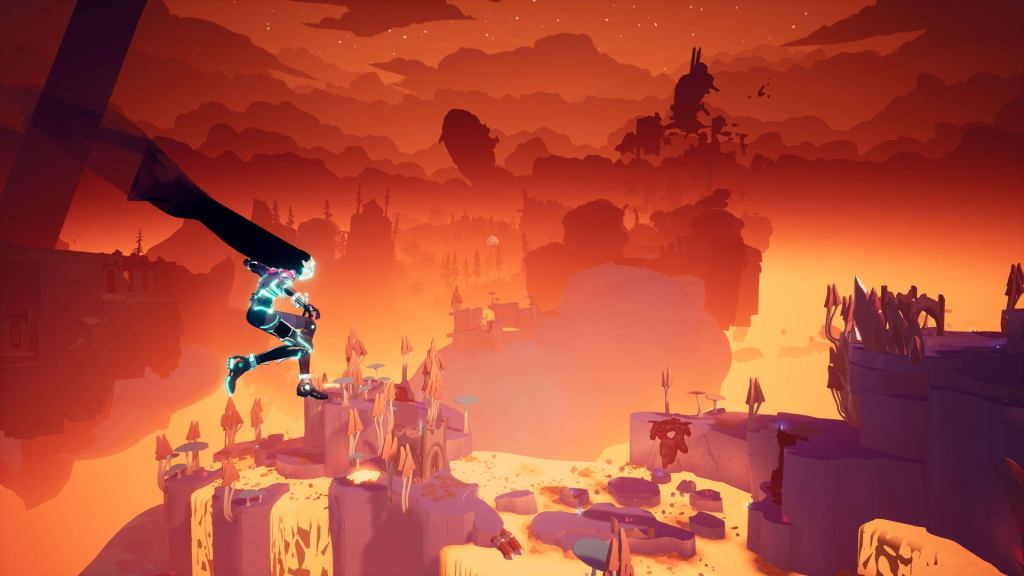In 2016, indie developer Heart Machine burst onto the scene with the crowdfunded gem Hyper Light Drifter, a 2D action/adventure game influenced by classics like A Link to the Past and Diablo. The game’s powerful visual and audio aesthetic helped blend the disparate influences encoded into DNA, creating a whole many times greater than the sum of its parts. Since then, Heart Machine has been working on its follow-up, Solar Ash. The game represents a jump from 2D to 3D gameplay, a vast threshold for any indie developer to cross. The game’s aesthetic vibe is similar to that of Hyper Light Drifter, serving as Heart Machine’s signature, and like its predecessor, it borrows ideas from great games that have come before it. This time, though, those influences don’t come together as seamlessly, resulting in a sophomore outing that’s messier, which isn’t to say it’s without its rewards.
Videos by ComicBook.com
In Solar Ash, players control Rei. She’s a voidrunner on a final Hail Mary mission to save her doomed world. Rei awakens inside the mysterious, all-consuming realm called the Void at the beginning of the game, rendered in neon hues similar to Hyper Light Drifter‘s palette. Despite embarking on the mission as part of a small team, she finds herself alone, and, to make matters worse, the Starseed, the device meant to destroy the Void and save her planet, isn’t active. The players must control Rei as she attempts to power the Starseed back up and maybe discover what happened to her fellow voidrunners along the way.

Rei doesn’t move like a typical 3D video-game adventurer. Equipped with footwear that functions like futuristic rollerblades, Rei glides over solid terrain and cosmic dust alike and grinds on the most precarious railings. The player’s ability to pull off quick tricks with Rei’s skill is put to the test every time she needs to clear out one of the anomalies blocking her from getting the Starseed back online. It brings to mind classic extreme sports games like the Tony Hawk’s Pro Skater series, Jet Set Radio, and SSX Tricky.
Once the anomalies are out of the way, Solar Ash‘s other major gameplay inspiration becomes clear. The game’s bosses are massive, towering creatures that resemble the titular being from Shadow of the Colossus (Solar Ash even goes as far as to lampshade this in one particularly familiar boss’ case). As Rei, players must jump onto these creatures and skate and swing her way across their bodies, stabbing at weak points in quick succession before the beast becomes too hot to touch. Though Shadow of the Colossus is the obvious comparison point, the fast, timing-based gameplay of these sequences also brings rhythm-based action games like Sayonara Wild Hearts and Thumper to mind.
While Solar Ash stands on the shoulders of giants, its inspirations and aesthetics are sometimes at odds. Disasterpiece provides a wonderfully moody ambient soundtrack for the game, but it sometimes feels at odds with the high-octane tricks players are attempting to pull off. Solar Ash wants players to wander in the same way they might do in a game like Journey, and it wants them to explore its landscapes, which felt similar to those in Monument Valley but viewed up close. But, Solar Ash’s Void often feels empty, inhabited only by a few nuisance enemies and side quest-giving NPCs. It’s like a skatepark without enough skaters.

Fighting the game’s massive bosses can sometimes be frustrating. Shadow of the Colossus created an epic feel by leveraging its grip mechanic and the slowness of the main character, making him feel small when cast against the scale of the colossi. Rei’s speed betrays that idea even as the game’s camera’s inability to keep up with her frustrates the player’s attempts to pull off the game’s most complex challenges.
But Solar Ash does have its thrills. There are moments — albeit too rare and too brief — when everything does come together, and there’s an adrenaline rush as Rei stabs at the eye of another gooey anomaly or burdensome boss. There are also surprising themes that emerge as players progress through Solar Ash‘s story. At first, it seems another entry in the growing oeuvre of stories about fighting a climate disaster, fixing that which self-interested establishment leaders could or would not. But late in the game, the narrative takes a turn and becomes a much more meditative and reflective tale about acceptance and moving forward despite failure. It’s possible to interpret it as being dour, even fatalistic or defeatist, but it’s more about growth in the face of loss and an uncertain future than accepting defeat.
I feel comfortable saying that Solar Ash is going to be someone’s favorite game. It has a singular artistic vision and a strong enough message that, for the right person at the right time in their life, it’s going to ring true in a way that will resonate with them, perhaps like no other work of art. It’s also hard to deny the game’s visual splendor. For me, it is a game that I wish I loved, but only liked, and I fear that will be the most common experience. There are a few too many flaws to overlook, and it’s hard not to compare it to the masterpieces it hoped to emulate. That said, the video game world could do with more ambitious, imperfect works like Solar Ash and fewer safer bets. It may not be quite the masterwork that Hyper Light Drifter was, but it’s still likely to stick with you after the credits roll.
Rating: 3 out of 5
Solar Ash is available now on PlayStation 4, PlayStation 5, and PC. The publisher provided a game code for the purposes of this review, and it was reviewed on a PlayStation 5.








